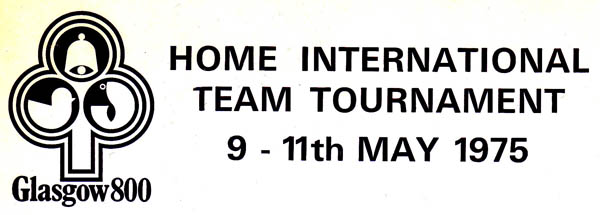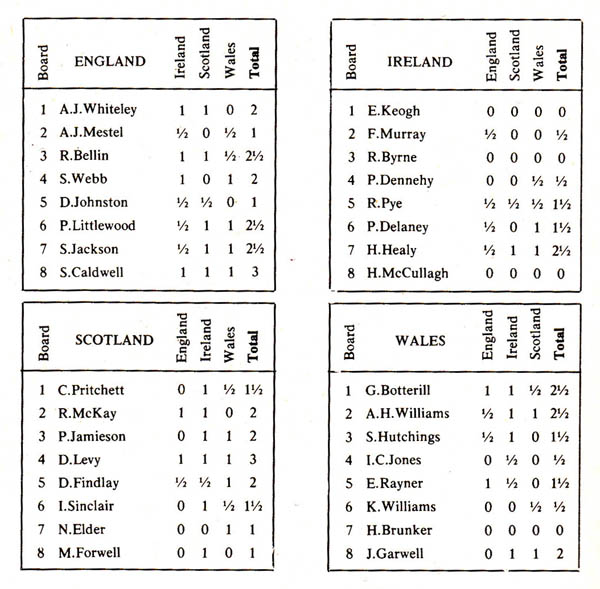
|
|
|
Home International Team Tournament 1975
Glasgow 800 Cup
May 9-11, Langside Hall, Glasgow
From the British Chess Magazine, July 1975, pp. 309-311
by Craig W. Pritchett
How the Hastings Chess Congress would have envied us. Money was no problem at a chess tournament for a change!
When Glasgow Corporation approached the Glasgow Chess Congress Committee with a generous grant of money to organise a chess event within the framework of the city's '800' celebrations (of the granting of the Royal Charter to the town 800 years ago), it came right of the blue. Quickly brains worked, and the idea of a Home Countries' Team International finally emerged. There was money for each team's accommodation and travelling expenses, enough to cover a sumptuous dinner for some 60 guests at the City Hall, and still more left over to purchase a beautiful silver trophy, the Glasgow 800 Cup, as well as 8 smaller silver cups to go to the individual members of the winning team in perpetuity. The event came off, and was a 'hit' with all the players and officials concerned.
England won the Cup, but only just. Final games-points totals (match points only counted in the event of a tie) were England 16½, Scotland 14, Wales 11 and Ireland 6½, which might seem to indicate a comfortable English victory, except that these totals hide the fact that it was only England's women who got their team through. Played over 4 men's and 2 junior (U-21) boards, 1 woman's and 1 girl's (U-18) board, the event saw what was almost a no-contest on the ladies' boards, where only Hilary Healy of Ireland was able to take a ½ point from the two promising young English girls, Sheila Jackson and Susan Caldwell. Without the women, Scotland would have finished ahead with 12 points to England's 11 and Wales' 9. Clearly, there was competition here and even had the English men been at their strongest, they would still not have found it too easy.
At the dinner, on May 10th, between the final course, the highland bagpipe and a lilting Irish song, the Presidents of the four national federations expressed their intention to recommend to their appropriate executives that the Home Countries' International become a regular biennial event, taking place every non-Olympiad year. It seems an excellent idea and ought surely to be adopted.
A few games from the event.
R.M. McKay (Scotland) - J. Mestel (England)
Glasgow 800 Home International Team Tournament
Round 1, 9 May 1975
Board 2
Notes by W.R. Hartston in the British Chess Magazine, July 1975, pp. 295-6.
1. e4 c5 2. Nf3 d6 3. d4 cxd4 4. Nxd4 Nf6 5. Nc3 g6 6. Be3 Bg7 7. f3 O-O 8. Qd2 Nc6 9. g4!? This overtly aggressive move has been paid more serious attention in recent years and now rates with 9. 0-0-0 as the most interesting alternative to 9. Bc4. The latter move is still, however, by far the most respected and feared.}
9...Be6 Black has several good alternatives here, of which 9...Nxd4 is the most usual. Very logical too is Miles' 9...e6 intending a quick ...d5 according to the classical recipe of reacting in the centre to an early
wing attack; with this idea Miles won a crucial game against the Russian Kochiev in the World Junior Championship last year.}10. O-O-O Rc8? I am not quite sure whether it is this move or the following two which deserves the
marks of censure; together they form the start of a plan just too slow to have any effect on the automatic White attack on the king's side. Best is 10... Nxd4 11. Bxd4 Qa5 12. Kb1 Rfc8, when it is less easy for White to pursue his attack.11. h4 Qa5 12. a3 A necessary precaution against possibilities of ...Nxd4 followed by ...Rxc3 and ...Qxa2.
12...Ne5 Establishing a piece on ...c4 is a normal procedure in more usual lines of the Dragon, but here White has saved time for his king's side pawn advance by not playing Bc4 and Bb3. Black's plan falls short by a single move, a difficult thing to see when deciding on it at move ten! One just has to guess these things, so it is a little hard to criticise Mestel too harshly for guessing the wrong way.
13. h5 Bc4 14. Bh6 Bxh6 Black suddenly realises that after 14... Bxf1 15. Bxg7 Kxg7 16. hxg6, the recapture with the f-pawn lets a white knight in at e6. The idea of exchanging white-squared bishops has not brought unmitigated joy. Suddenly, as so often in the Dragon, Black realises that he is totally lost and can do nothing about it (compare Karpov-Korchnoi Game No. 2 for a more high-class version of the same phenomenon).
15. Qxh6 Bxf1 16. Nd5! Quite devastating, for after 16...Nxd5; 17. hxg6 Nf6; 18. Nf5 it is all over.
16...Nd3+ Ingenious, but not quite enough.
17. Kb1! Avoiding the trap of 17. Rxd3? Nxd5 18. hxg6 Qe1+ 19. Rd1 Qe3+ (exchanging queens to stop the white attack.)
17... Rc7 {A sorry sort of move, played in the hope of defending along the second rank with this rook, but the onslaught can ignore it.
18. g5 Nxh5 19. Rxh5 gxh5 20. Nf5 Black resigned.
This sort of game used to be very common in the 1950s (before the present loser was born). It is nice to be reminded from time to time that a good old-fashioned crude attack can still bring results despite the sophistication of modern opening theory.
P. Jamieson (Scotland) - S. Hutchings (Wales)
Glasgow 800 Home International Team Tournament
Round 3, 11 May 1975
Board 3
1. d4 Nf6 2. c4 c5 3. Nf3 cxd4 4. Nxd4 e6 5. g3 d5 6. Bg2 e5 7. Nf3 d4 8. O-O Nc6 9. Nbd2 Be7 10. a3 a5 11. b3 O-O 12. Qc2 h6 13. e4 dxe3 14. fxe3 Ng4 15. Re1 Bc5 16. Ne4 Bf5 17. Nh4 Bh7 18. Qe2 Bxe4 19. Bxe4 Nf6 20. Bc2 Qd7 21. Rf1 Qg4 22. Qg2 Nd4 23. exd4 Bxd4+ 24. Kh1 Bxa1 25. Rxf6 gxf6 26. Nf5 Kh8 27. Nxh6 Qh5 28. g4 Qh4 29. Qe4 f5 30. Qxf5 e4 31. Bxe4 Qe1+ 32. Kg2 Kg7 33. Bg5 (33. Qh7+ Kf6 34. Bg5+!) 33... Qe2+ 34. Kh3 1-0
I.C. Jones (Wales) - D.N.L. Levy (Scotland)
Glasgow 800 Home International Team Tournament
Round 3, 11 May 1975
Board 4
Notes by Levy (except where stated) in Scottish Chess, Nr. 38, June 1975.
To some extent this was agrudge match for me. Had I won against Jones at Nice [the Olympiad - AMcG] from an overwhelming position Scotland, and not Wales, would have reached the 'A' final.
1. Nf3 f5 2. c4 Nf6 3. g3 d6 4. d4 e6 5. Bg2 Be7 6. Nc3 O-O 7. O-O a5 Simagin's move, aimed at claiming some space on the Q-side before beginning action on the other wing.}
8. Qb3?! Unthematic. 8. b3 is correct.
8... Kh8 9. Rd1?! Unthematic. White should aim for e4.
9...Qe8 10. Bg5 Nc6 If White is fortunate enough to remove Black's KP in the Dutch Defence he can enjoy
tremendous pressure on the white squares. For this reason 11. d5 looks a powerful way to test Black's last move. Against 11...Ne5, 12. Nd4 looks good for White. Against 11...Nb4 12. Nd4 is less inviting because of the possibility of 12...Nf6xd5, but 12. dxe6 Bxe6 13. Nd4 is attractive. And if Black tries to cover e6 by retreating 11...Nd8 White has the truly entrancing resource 12. Nb5 Qd7 13. Ne5!! winning the exchange. The exchange of pawns 11.. exd5 12. cxd5 also leaves White dominating the position (Scottish Chess games editor N.J. Young).11. Nb5 Bd8 12. Rac1 White could still have played d5 with some effect, but prefers to make another developing move to reinforce his intended advance. The trouble is that after the following manoeuvre by Black he cannot actually carry out this advance on account of the unhappy placing of his QN (games editor).}
12...a4!? I wasn't convinced that this move was objectively good - in some lines the a-pawn becomes very vulnerable. My play was governed by the fact that we needed a big score in this match to stand any chance of catching England, and I wanted to create an unbalanced position in the expectation that it would upset my opponent's peaceful nature.
13. Qa3 Ne7 14. Qd3 So that the b5 knight is defended after 15. c5.
14...Ne4 15. Be3 c6 16. Nc3 d5 17. Ne5 Ng6 18. Nxg6+ Qxg6 19. Nxe4 fxe4 20. Qa3 Qf7 21. f3 Be7 22. Qc3 exf3 23. Rf1 Qg6 24. Rxf3 Rxf3 25. Bxf3 Bd7 Now, at last, Black has more or less completed his development and threatens ...h7-h7 and ...h4 with some (not many) prospects on the K-side.
26. Qc2 Qxc2 27. Rxc2 About this time, as I later discovered, my opponent was telling everyone that he had an easy draw. Strangely enough I felt, for the first time in the game, that I actually stood better despite my backward KP. How can Black be better? (1) White has three pawn islands, Black only two; (2) Black has the threat ...Ra6-b6, putting pressure on White's b-pawn; (3) after Black's next move his bishops are more active than White's.
27...Be8 28. Bg4 Bf7 Threatening 29...dxc4 30. Rxc4 e5 31. R moves exd4 32. Bxd4 Bxa2.
29. cxd5 If 29. c5 Ra5 followed by ...Rb5, ...Bf6, ...e5 with pressure against White's Q-side pawns.
29... exd5 30. Bf4 Bg6 31. Rc3 If 31. Rc1 Ra5 and 32...Rb5.
31... h5 32. Bd7 Bb4 33. Re3 Be4 34. a3 Ba5 Not 34... Bd2?? 35. Rxe4!
35. g4 After this move White is lost, but if 35. Kf2 Bb6 36. Be5 c5, and if 35. Kf1 Rd8 36. Bh3 (or 36. Be6 Re8 37. Bf7 Rf8 38. Bxh5 g5) 36... Rf8 37. Kg1 Bb6 38. Be5 c5 etc. and 35. Be5 loses to Bd2, so it looks as though White is lost anyway.
35... Rf8 36. Be5 Be1! 37. Bf5 Or 37. Rh3 Bf2+ 38. Kf1 Bxd4+.
37... hxg4 38. Kf1? Bd2 39. Rg3 Bxf5 White lost on time. 0-1
Footnote
The plans to hold this event on a regular basis did not come to fruition. However, some years later, and attempt was made to hold something similar, the Celtic Triangular Tournament, involving Scotland, Wales and Ireland. Details can be found here.
|
|

